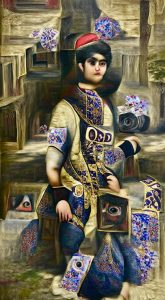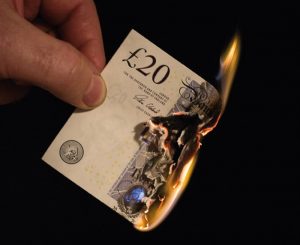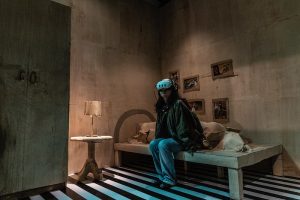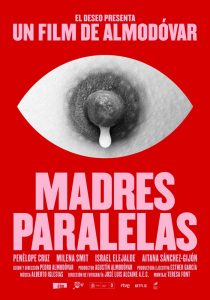I am born chinese, raised american, and now because chinese art is so hot, chinese once more. That’s the bio, the very concise bio of Jay Yan.
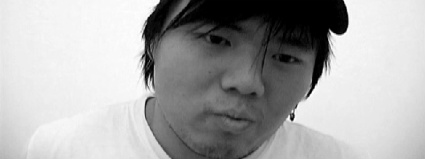 iwanttogoutwithyou.com, 2007
iwanttogoutwithyou.com, 2007
A couple of years ago, Jiacong “jay” Yan completed his degree at the cradle of young talents that is UCLA Design|Media Arts Department. He lives in Los Angeles where he works as a media artist and designer.
Fresh from UCLA, Jay started exhibiting his installations and videos in galleries in the U.S., in Asia and in Europe as well. Let’s see if i manage to get a few words from the most laconic artists i’ve ever come upon:
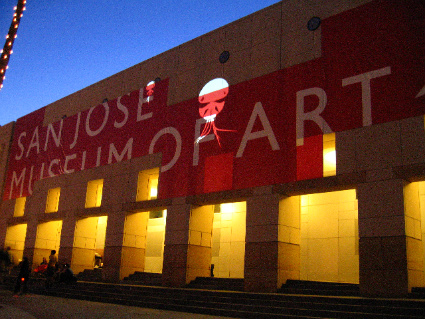 We Only Come Out at Night, 2008
We Only Come Out at Night, 2008
I decided to interview you for two reason. The obvious one is that i like your work.
Thank you.
De nada! The second one is that your bio made me laugh: “I am born chinese, raised american, and now because chinese art is so hot, chinese once more.” A project of yours, Stealing Art makes me think that you like to play with your double identity (or whichever way you’d define it). Can you explain us your project? What motivated the performance and how did gallery visitors react to it?
Stealing Art, to put it simply, is my chinese cultural take on John Baltessari’s famous piece, Singing Sol LeWitt
I was in Shanghai buying bootleg DVDs from a street vendor and noticed an unpopular movie had pictures of Angelina Jolie on the cover even though she was not in the movie. I asked the mechant why this was there if she was not in the movie, and he said, because her face sells more DVDs. I thought this was hilarious! Not only are they selling bootlegs, but they modify the cover art to popularize the movie.
When I got back to the US, the latest issue then of Art Forum featured a big article on the art market and predictions of the future. One article complained about artists, whose work can easily be duplicated, still limiting their editions to 3 in order to drive up individual prices but this prevents everyone except the economically wealthy to buy such works. Now I’m not trying to destroy the value of these video art pieces, it’s more along the lines of how Murakami works. He produces so much toys and t-shirts that he makes very little on (apparently one painting sale is a match to his merchandising profits according to the MOCA curator) but they are still important to popularize his work. So I think of Stealing Art in much the same way. Collectors who always want the original with proof of authenticity will always buy the real work, why would a badly recorded dvd be as interesting to them as a collectable?
I actually intentionally tried to make it as bad as I can. It is the BADNESS of it that makes it something. I’ve seen projects by others who try to sell bootleg art, either downloaded from the internet or photographs of art, but they all try to pass off as the art work instead of a new art work. In each DVD, I made them in the exact style of a Chinese bootleg DVD you would find on the streets of Shanghai. You see the reflection off the TV of me behind the camera (referencing to the often seen man standing up at the movie theater at the bottom of the screen). The cover art is overly bright colored and with bold 3D letters (I was modeling them off porn DVD covers). The back of the DVDs are filled with non-sense text (Chinese bootlegs are filled with non-sense text to try to make them look more legitimate). I even included the thin plastic wrapping pouch that bootleg DVDs are sold in.
 Art of Stealing Art, 2008
Art of Stealing Art, 2008
At the day of the opening, I knew two of the artists were going to be present because they were giving small talks, I set up a cardboard stand in front of the space with the bootlegs and people immediately started buying them. One was purchased for Guido van der Werve as a gift from his friend and I think he was kind of shocked because he immediately ran outside. I’m not entirely sure if he comprehended what was going on but he took one look and then went back in, not really talking to me. Marco Schuler was much more cool about it. He came up to me and bought a DVD himself, but complained that since he made the original video, I should give him a discount. He gave me his card telling me to get in touch with him but I’m afraid he wants to sue me. All the DVDs sold out in 30 minutes.
I really want to do this at the Shanghai Biennale actually, I think it would be great. I just don’t know a way to get access to the videos they show before the opening…
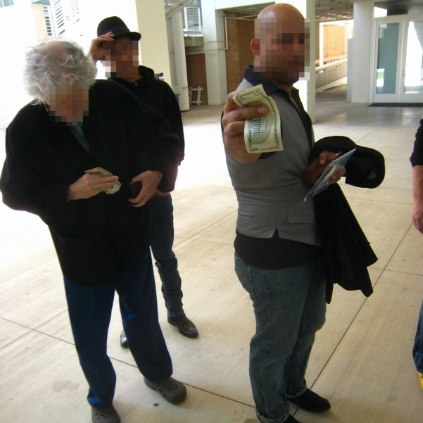 Art of Stealing Art, 2008
Art of Stealing Art, 2008
Surely there must be more to being Chinese than surfing on the wave on the “Chinese art is hot’ trend. So how do you navigate between two different countries so different? Do you show your artwork in China? Do you have a strong relationship with the art community over there?
Well, funny things happen when I show work overseas. I work out of the USA, my information is from the USA, but somehow they always find out I’m Chinese, so next to my name it would appear: Jay Yan (USA/CHINA) without me even saying anything.
I am not the expert on Chinese Contemporary Art, 90% of it stems from just long conversations about it with a Collector that likes me, Guan Yi, from Beijing.
Luckily he is one of the top Chinese Collectors with excellent tastes (and I’m not just saying that because he bought my work) and he really introduced me to Chinese Comtemporary Art. As I walked through his private collection, it was a complete history lesson on Chinese avant garde art. He introduced me to my heroes like his friend Ai Wei Wei and the works of Zhang Huan (whom you’ve written about next to my work, which I was flipping with joy about). He told me about the “China / Avant Garde” show in 1989 that was shut down by the Beijing Police and about how the artist Xiao Lu shot at her own installation. It sounded like an amazing time at which point I told him about this idea I had of graffiting Tian An Men square with time delayed paint so the paint wouldn’t show up tills days later. The conversation got a little more serious and I understood the time was still not right for such a daring act.
A cab driver in Beijing once told me “when you are unknown, it’s ok to experiment and do crazy things, just not political. When you are somewhat known, it’s better to be safe, because they can still make you disappear and no one would care. When you are famous, then you are too well known and you can start doing whatever you want again…. but still be careful of the political stuff.”
I do not show my work there as often but I help my friend setup her work in China sometimes and I always pretend to not speak a word of chinese because if you are a foreigner, they treat you better. They get you a translator, which doubles as your assistant, and they are way more willing to help you. The best part is, if they talk in front of me in chinese about how they are going to cut corners on the installation, I can catch them (sadly, this happens more than I would like). It’s a weird system, you have to know who to bribe so you get the best work from their staff etc.
I left China at the age of 6 in 1990 so I can not make work about the culture, just make works about the things I find interesting from an outside perspective. Every time I go to Shanghai, I find funny things that the culture does. Like when I was young, I tried to go to a video game arcade in Shanghai and I got yelled at by all the men inside for trying to go to the arcade because children weren’t allowed back then.
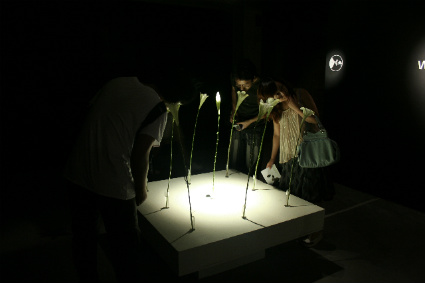 Whisper, 2005
Whisper, 2005
The installation Whisper looks extremely poetic
Thank you
…but your description of the project is a bit laconic.
I try to not talk so much in my descriptions so makes interviews like this more interesting
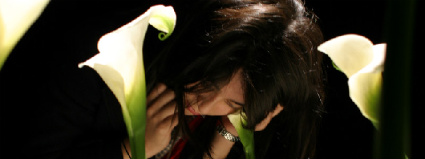 Whisper, 2005
Whisper, 2005
How does it work technically?
I keep my description laconic to avoid people thinking about this question.
It works by placing speakers underneath a vase with flowers. The speaker vibrates the vase and the flower to audible frequencies. The base stand is then soundproofed to block out all sounds except those coming from the flowers. The Calla Lily flower was chosen because it’s stiff stem carried the vibrations well, and the trumpet shape of the flower amplified the sound.
I suspect it must have been difficult to work with something as delicate as flowers?
Physically, not really, the flowers are easy to replace as long as they are in season. If they are not, it’s a nightmare running around the city trying to find them.
Semiotically, flowers have a long history in art. I try to reference both O’Keefe and Mapplethorpe in the piece, these flowers have such a strong context and simple form that it was really hard finding the appropriate sound to play through them.
 Cutting Board, 2005
Cutting Board, 2005
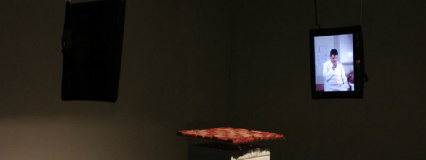 Cutting Board, 2005
Cutting Board, 2005
Apart from flowers you also worked with meat in the past. What exactly attracts you with organic materials?
I wondered what butchers do when they’re bored.
Your portfolio is impressive for the diversity of the projects developed.
I don’t think art is about how well you do or make something anymore, it’s about how great your idea is and how to execute it in the best possible way.
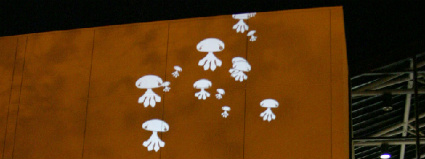 Through the Empty Space, 2006
Through the Empty Space, 2006
Do you manage to live from your art?
I wish. Dynamic art requires computers, displays, cameras and the equipment cost for one piece already pushes a work past $5000 and that’s before the artist and the dealer’s share. Jennifer Steinkamp taught me how to package a work and set it up easily for collectors, but you have to be her to charge an amount that makes sense for everyone.
Do you, like many media artists, work sometimes for communication agencies or as teachers in order to make ends meet?
I help artists create detailed visualizations of their ideas for proposals or for direct art fabrication.
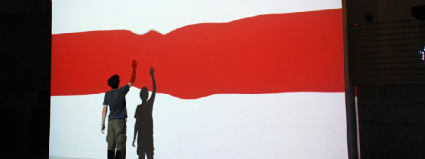 Untitled Red Stripe, 2008
Untitled Red Stripe, 2008
How much do you manage to control the way people interact with your work?
Hiring a pretty girl to come every now and then and interact with the piece.
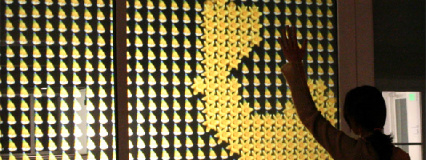 Pond, 2007
Pond, 2007
Which kind of unexpected behaviour have you witnessed with your installations?
The piece “throw your hands up” specifically comments on how funny people interact when you remove the actual installation and place their behavior out of context. Most people just wave their arms in the air because they are too embarrassed in a gallery setting to do anything else really. The “we only come out at night” piece has attracted singing, people offering up their baby and women flashing their breasts at it
Any bad or good surprise? What have you learnt from the way people interact with your works?
For unexpected interesting interaction with your art piece, serve alcohol,
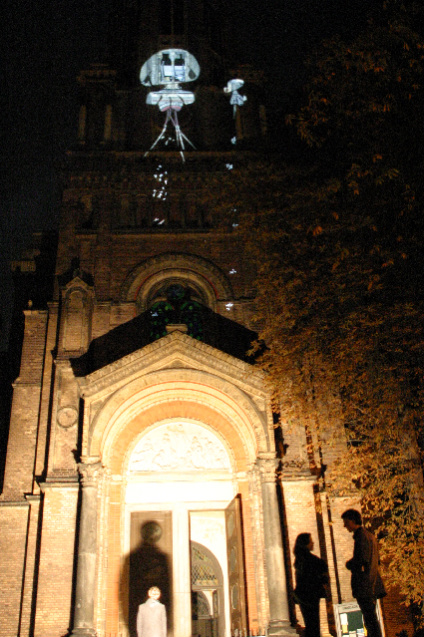 We Only Come Out at Night, 2008
We Only Come Out at Night, 2008
Is there any place in the world where you’d love to project your interactive projections?
On the portrait of Mao @ Tian An Men Square,
Or on anything Pablo Valbuena plans to project onto, I had a great time at the last Today’s Art projecting over his piece and we had a good laugh about it. I made a piece that was on wheels allowing me to project all over the city and interact with the people below. I then started projecting on the other art works at the show using my piece to “attack” their pieces. Some people really loved the idea of two projection pieces interacting, but this one girl yelled at me for 10 minutes about how I should be ashamed of myself.
I am now interested in my much more simplistic interactive projection pieces like pieces from the “projections for a large wall” series. I want to find some nice curved spaces, odd shaped walls to divide with 2 colors or a simple colored line that one can manipulate.
Who are the artists that have influenced you or of whom you particularly appreciate?
I’ve been friends with Christian Moeller and Casey Reas for almost 6 years now. They introduced me to art and really helped and encouraged me through my career. I went through a Bas Jan Ader phase for 2 years which threw me off because it was such an romantic emotional style of work that I had never done before. I watched Bas Jan Ader’s piece “I am too sad to tell you” and thought this was the greatest art piece I have ever seen. Ai Wei Wei keeps me interested in contemporary chinese art. I’m currently on an Ellsworth Kelly kick .
Any upcoming project you could share with us?
I will no longer use the random() function in any of my future pieces.
 I asked Jay to send me a photo of his working space and this is what he emailed me
I asked Jay to send me a photo of his working space and this is what he emailed me
I have an upcoming show at the new Di Yu Gallery in Shanghai.
I am currently trying to get my hands on a replica of the gun that shot Andy Warhol (the original is locked up at Riker Island in New York). I want to make short line of electronic toy guns that you can point at an art work and Andy Warhol, in his voice, will tell you whether it’s art or not. Thus we can have a device that will finally tell us whether something is art or not. It’s also kind of a homage to Xiao Lu’s performance during the China \ Avant Garde show.
Thanks Jay!

